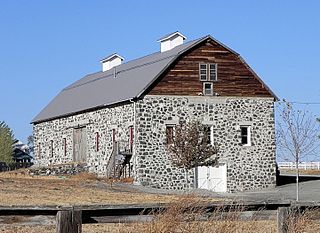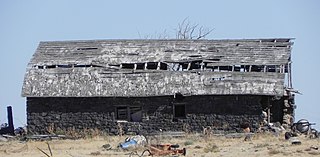Related Research Articles

The Buhl IOOF Building in Buhl, Idaho is an Odd Fellows building that was built in 1919-20. It served historically as a clubhouse, as a meeting hall, as a specialty store, and as a business. It was designed in the early commercial style, perhaps the Chicago style. It was listed on the National Register of Historic Places in 1984.

The Round Barn, Bruce Township Section 6 was located in Bruce Township, Benton County, Iowa, United States. It was built in 1914 as a general purpose barn. The building was a true round barn that measured 60 feet (18 m) in diameter. The barn was constructed of clay tile from the Johnston Brothers' Clay Works and it featured a conical roof. The structure did not have a cupola, but there was a silo that rose from the center. It was listed on the National Register of Historic Places (NRHP) in 1986.
Thomas Henry Morgan was an architect in the U.S. state of Georgia.
Cannon & Fetzer was an American architectural firm that operated between 1909-1937 in Salt Lake City, Utah. Lewis T. Cannon and John Fetzer were the principal architects. A number of its works are listed on the U.S. National Register of Historic Places. For a brief time between 1910-1915, the firm was named Cannon, Fetzer & Hansen after partnering with Ramm Hansen. Many of their works survive and are listed on the U.S. National Register of Historic Places.
John "Jack" Oughton was a skilled stonemason in Lincoln County, Idaho. A number of his works are listed on the U.S. National Register of Historic Places.

Ignacio Ygnatil Berriochoa was a skilled stonemason in Lincoln County, Idaho. He was born in the Basque region of Spain and moved to Idaho in 1904. He lived in Shoshone, Idaho from 1910 to 1949 where he was a farmer and sheepman. A number of his works are listed on the U.S. National Register of Historic Places.

The Jacob B. Van Wagener Barn is lava rock structure built in 1912. It located in Jerome, Idaho, United States, and was listed on the National Register of Historic Places in 1983.

The Manuel Silva Barn near Shoshone, Idaho, United States, was built in 1910 by stonemason Ignacio Berriochoa, who lived about 2 miles (3.2 km) away. It was listed on the National Register of Historic Places (NRHP) in 1983.

The Arthur D. Silva Water Tank near Shoshone, Idaho, United States, was built in 1910. It was a work of sheep rancher and stonemason Bill Darrah and of stonemasons Pete Duffy & Sons. It was listed on the National Register of Historic Places in 1983.

The T. P. Bowlby Barn, northeast of Buhl, Idaho, was built in 1912 by Henry Schick, a German-Russian immigrant to the United States. It was listed on the National Register of Historic Places in 1983.

The Dau-Webbenhorst Barn, southeast of Buhl, Idaho, was built in 1913 by Henry Schick, a German-Russian immigrant to the United States. It was listed on the National Register of Historic Places in 1983.

The Art and Frieda Maxwell Barn, southeast of Buhl, Idaho, United States, was built in 1915 by Henry Schick, a German-Russian immigrant to the United States. It was listed on the National Register of Historic Places in 1983.

The Henry Schick Barn, located southeast of Buhl, Idaho, was built in 1914 by Henry Schick, a German-Russian immigrant to the United States. It was listed on the National Register of Historic Places in 1983. The barn features walls and milking stalls that were cast in place in concrete, and custom-made metal onion domes.

The Schick–Ostolasa Farmstead, at 5213 Dry Creek Rd., Boise, Idaho, is listed on the National Register of Historic Places. The Schick family were German-Russian immigrants to the United States.

The Buhler House is a historic house at 1820 Fair Park Boulevard in Little Rock, Arkansas. It is a 2-1/2 story structure, its exterior clad in brick, set on a field stone foundation. Stylistically it is in the English Revival, with a tile roof and trim elements of concrete. The house's most distinctive feature is its internal frame, which is constructed entirely out of steel beams. Its exterior and interior door frames are also steel, as is the front door, which has been processed to resemble walnut. It was built in 1930-31 by Henry Buhler, owner of a local real estate development firm. No other residential structure in the state has been documented to have this type of construction.
Nisbet & Paradice was an architectural firm in Idaho. It was a partnership of architects Benjamin Morgan Nisbet and Frank H. Paradice, Jr. formed in 1909. The partnership lasted five years. They dissolved it in 1915, and Nisbet moved to Twin Falls, Idaho to establish an individual practice, and Paradice did likewise in Pocatello, Idaho. A number of their works are recognized by listings on the National Register of Historic Places (NRHP).

The Burton Morse House, at 136 Tenth Ave. N. in Twin Falls, Idaho, was built in 1908. It was listed on the National Register of Historic Places in 1993.
Burton Morse ), or Burton E. Morse, was an architect based in Twin Falls in the U.S. state of Idaho. Several of his works are listed on the National Register of Historic Places (NRHP).

The Rudolf Kunze Barn, in Twin Falls County, Idaho near Buhl, Idaho, was built in 1915. It was listed on the National Register of Historic Places in 1983, then removed in 1989 in a procedural error, then relisted in 1994.
James H. Nave was an American architect based in Lewiston, Idaho. He designed a number of works which are listed on the National Register of Historic Places (NRHP) for their architecture.
References
- ↑ Idaho Heritage page
- ↑ Madeline Buckendorf (July 13, 1983). "National Register of Historic Places Inventory-Nomination: Buhl Dairy Barns TR". National Park Service.
- 1 2 3 4 5 "National Register Information System". National Register of Historic Places . National Park Service. July 9, 2010.
| This article about a United States architect or architectural firm is a stub. You can help Wikipedia by expanding it. |